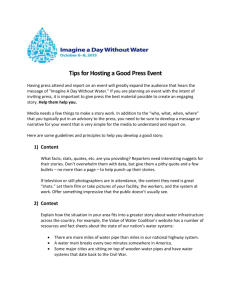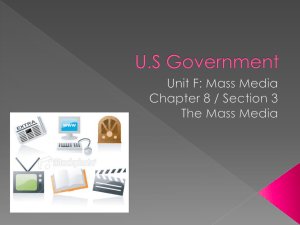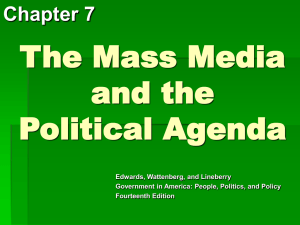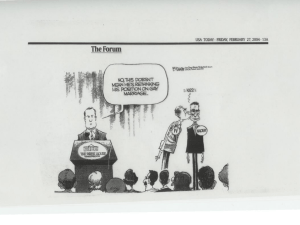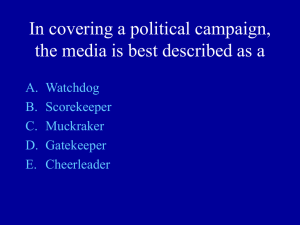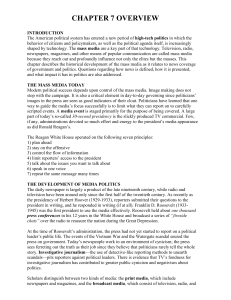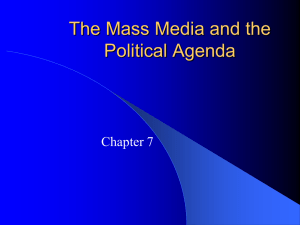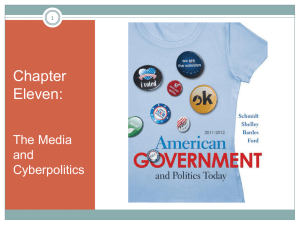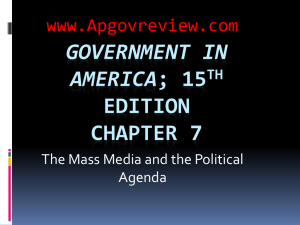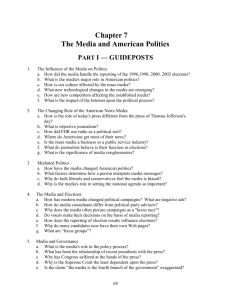Mass Media & Political Agenda: AP Government Outline
advertisement
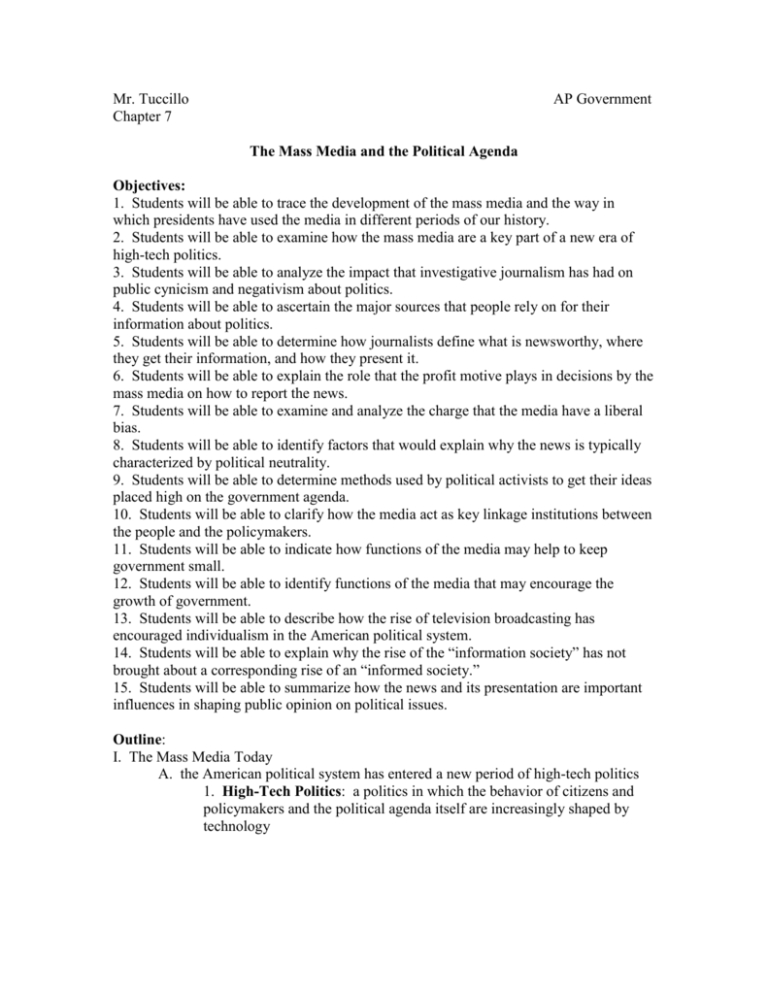
Mr. Tuccillo Chapter 7 AP Government The Mass Media and the Political Agenda Objectives: 1. Students will be able to trace the development of the mass media and the way in which presidents have used the media in different periods of our history. 2. Students will be able to examine how the mass media are a key part of a new era of high-tech politics. 3. Students will be able to analyze the impact that investigative journalism has had on public cynicism and negativism about politics. 4. Students will be able to ascertain the major sources that people rely on for their information about politics. 5. Students will be able to determine how journalists define what is newsworthy, where they get their information, and how they present it. 6. Students will be able to explain the role that the profit motive plays in decisions by the mass media on how to report the news. 7. Students will be able to examine and analyze the charge that the media have a liberal bias. 8. Students will be able to identify factors that would explain why the news is typically characterized by political neutrality. 9. Students will be able to determine methods used by political activists to get their ideas placed high on the government agenda. 10. Students will be able to clarify how the media act as key linkage institutions between the people and the policymakers. 11. Students will be able to indicate how functions of the media may help to keep government small. 12. Students will be able to identify functions of the media that may encourage the growth of government. 13. Students will be able to describe how the rise of television broadcasting has encouraged individualism in the American political system. 14. Students will be able to explain why the rise of the “information society” has not brought about a corresponding rise of an “informed society.” 15. Students will be able to summarize how the news and its presentation are important influences in shaping public opinion on political issues. Outline: I. The Mass Media Today A. the American political system has entered a new period of high-tech politics 1. High-Tech Politics: a politics in which the behavior of citizens and policymakers and the political agenda itself are increasingly shaped by technology B. the mass media are a key part of this technology 1. Mass Media: television, radio, newspapers, magazines, and other means of popular communication are called the mass media because they reach out and profoundly influence not only the elites, but the masses C. effectively communicating a message is critical to political success 1. the key is gaining control over the political agenda, which involves getting one’s priorities presented at the top of the daily news 2. Media Event: events purposely staged for the media that nonetheless looks spontaneous 3. a large part of today’s so-called 30-second presidency is the TV commercial a. ~60% of presidential campaign spending is used for TV ads D. politicians’ images in the press are seen as good indicators of their clout 1. image is especially important for presidents II. The Development of Media Politics A. the daily newspaper is largely a product of the mid-nineteenth century and radio and television have been around only since the first half of the twentieth century B. up through the Hoover administration, reporters submitted their questions to the president in writing, and he responded in writing (if at all) C. FDR was the president who invented media politics – to him the media was a potential ally and he promised them at least two press conferences a week 1. Press Conferences: meetings of public officials with reporters 2. FDR was also the 1st president to use the radio (fireside chats) 3. at the time of FDR, the press had not yet started to report on a political leader’s private life a. they never even reported that FDR was in a wheelchair D. up until 1961 many reporters saw themselves as an extension of the government and they pretty much accepted whatever the government told them 1. the events of Vietnam and the Watergate scandal hanged this 2. today’s newspeople work in an environment of cynicism; they feel politicians rarely tell the whole story and it is their job to seek out and report the truth 3. Investigative Journalism: the use of detectivelike reporting to unearth scandals, scams, and schemes, putting reporters in adversarial relationships with political leaders a. many analysts agree that the most important change in media coverage of politics in recent years has been the much greater scrutiny which politicians are now subjected b. there is evidence that TV’s fondness for investigative journalism has contributed to greater public cynicism and negativism about politics E. scholars distinguish between two kinds of media 1. Print Media: newspapers and magazines 2. Broadcast Media: television, radio, and the Internet F. The Print Media 1. Newspapers a. the first daily newspaper was printed in Philadelphia in 1783, but such papers did not become common until the technological advances of the 19th century 1. rapid printing and cheap paper made the “penny press” possible 2. 1841 - New York Tribune was founded 3. 1951 - New York Times was started b. in the 1840s, the telegraph permitted “wire service”, which relayed news stories from city to city faster than ever before 1. the Associated Press, founded in 1849, relied heavily on this c. newspaper journalists Joseph Pulitzer and William Randolph Hearst really livened up journalism at the turn of the 20th century with “yellow journalism” 1. their main topics were sensationalized (and embellished) stories on violence, corruption, wars, and gossip d. Newspaper Chains: newspapers published by massive media conglomerates that account for almost three-quarters of the nation’s daily circulation 1. newspapers turned into chains during the early part of the 20th century 2. today’s conglomerates (Gannett, Knight-Ridder, and Newhouse are the largest) control newspapers with 78% of the nations daily circulation a. often these chains control television and radio stations as well e. among the most influential newspapers today are The New York Times (considered the best), Washington Post (probably the best coverage inside Washington) and papers from major cities like the Chicago Tribune and The Los Angeles Times and others are the major ones 1. for most newspapers in medium-sized and small towns, the main source of national and world news is the Associated Press wire service 2. Magazines a. the political content of leading magazines is pretty slim b. the newsweeklies such as Time, Newsweek, and U.S. News and World Report rank well behind popular favorites such as the Reader’s Digest, TV Guide, and National Geographic c. with the exception of Time, the National Enquirer, Playboy, and People edge out Newsweek and the other new magazines in sales competition d. serious magazines of political news and opinion like the New Republic and National Review, are only read by the educated elite and are outsold by such magazines like Hot Rot and Weightwatchers Magazine G. The Broadcast Media 1. the broadcast media have displaced the print media as Americans’ principal source of news and information a. by the mid 1930s, radio ownership had become almost universal b. during World War II the radio really took off in the news business c. television began its early years in the 1950s and early 1960s 2. the first televised presidential debate was the 1960 Kennedy-Nixon debate a. the polls showed that people listening to the radio gave the edge to Nixon, but people who actually saw what the candidates looked like gave the edge to Kennedy 1. showed the visual power of television 3. television took the nation to the war in Vietnam during the 1960s a. TV exposed governmental naiveté (some say it was outright lying) about the progress of the war b. the American people watched the horrors of war through their TVs c. Johnson soon had two wars on his hands: one in Vietnam and the other at home with antiwar protesters 4. with the growth of cable TV, particularly the Cable News Network (CNN), television has recently entered a new era of bringing the news to people and to political leaders – as it happens 5. since 1963, surveys have consistently shown that more people rely on TV for the news than any other medium a. by a two-to-one margin, people think television reports are more believable than newspaper stories b. people believe more what they see H. Narrowcasting: Cable TV and the Internet 1. about two-thirds of the American public currently subscribes to cable television, giving them access to dozens of channels 2. people feel, based on developments with cable TV to date, that information about politics will be presented in a way that appeals to a rather narrow and specific audience rather than to the public at large 3. cable channels focus on a narrow particular interest a. Narrowcasting: as opposed to the traditional “broadcasting,” the appeal to a narrow, particular audience by channels such as ESPN, MTV, and C-SPAN, which focus on a narrow particular interest b. this is even truer for websites III. Reporting the News A. Defining News 1. news reporting is a business in America in which profits shape how journalists define what is newsworthy, where they get their information, and how they present it a. because some types of news stories attract more viewers or readers than others, certain biases are inherent in what the American public sees and reads 2. Edward J. Epstein found that some important characteristics of the TV news business result from the nation of the viewing audience a. in their pursuit of high ratings, news shows are tailored to a fairly low level of audience sophistication b. to a large extent, TV networks define news as what is entertaining to the average viewer B. Finding the News 1. most news stories come from well-established sources rather then by the crusading truth-seeker reporter 2. major news organizations assign their best reporters to particular beats a. Beats: specific locations from which news frequently eminates, such as Congress or the White House b. numerous studies of both the electronic and the print media have found that journalists rely almost exclusively on such established sources to get their information 3. those who make the news depend on the media to spread certain information and ideas to the general public a. Trial Balloons: an intentional news leak for the purpose of assessing the political reaction 4. in turn, reporters rely on public officials to keep them in the know a. official sources who have the information usually have the upper hand over those who merely report it 5. Crusading Truth Seekers a. Carl Bernstein and Bob Woodward of the Washington Post uncovered Watergate b. Jack Anderson regularly exposes the uglier side of government corruption and inefficiency c. journalists today assume that politicians have something to hide, and politicians assume that reporters are out to get them C. Presenting the News 1. once the news have been found, it has to be compressed into a 30second news segment or fit in among the advertisers in a newspaper 2. TV news is little more than a headline service, just skimming the top of the stories a. there are some shows like the MacNeil-Lehrer Newshour and Nightline in which stories are looked at for more than the usually minute they get on the regular news b. some news stories however, like things on nuclear power, the nation’s money supply, a study of the Medicare system. need more than just a few minutes in order to look into them 3. ironically, as technology has enabled the media to pass along information with greater speed, news coverage has become less thorough a. Sound Bites: short video clips of approximately 15 seconds, which are typically all that is shown from a politician’s speech or activities on the nightly television news D. Bias in the News 1. many people feel that the news has a liberal bias and there is some limited evidence to support that claim a. reporters are twice as likely to call themselves liberal than the general public b. in 1992 a survey found that 44% of journalists said they were democrats as opposed to 16% who said they were republican c. however, there is limited evidence that shows that journalists’ personal attitudes sway their reporting of the news d. the majority of studies done have said that most reporting is done without bias done in the “point / counterpoint” format and allows the reader to make their own conclusions 2. Why the news is typically characterized by political neutrality a. most reporters strongly believe in journalistic objectivity, especially because they ones that are good at it get rewarded by their editors b. media outlets have a direct financial stake in attracting viewers and subscribers and do not want to lose their audience by appearing biased 3. even though there may not be too much partisan bias in the news there is still some types of bias that exists a. reporters tend to focus on stories that will draw the largest audiences 1. surveys show that people are most fascinated by stories about conflict, violence, disaster, or scandal 2. good news is unexciting b. television is particularly biased toward stories that generate good pictures c. Talking Head: a shot of a person’s face talking directly to the camera 1. this is considered boring is usually avoided because it does not grab viewer’s interest IV. The News and Public Opinion A. studying the effects of the news media in people’s opinions and behaviors is difficult to do 1. it is hard to separate the media from other influences on people to see which one has the biggest effect if one at all 2. also the effect of one news story on people may be trivial, but the cumulative effect of dozens of news stories may be important B. there is evidence that the news and its presentation are important in shaping public opinion about political issues 1. the decision to cover or ignore certain issues can affect public opinion 2. by focusing public attention on specific problems, the media can alter the priorities Americans attach to a circumscribed set of problems and also influence the criteria by which the public evaluates political leaders C. much remains unknown about the effects of the media and the news on American political behavior, however, enough is known to conclude that the media are a key political institution V. The Media’s Agenda-Setting Function A. as was explained in Chapter 1, people are trying to influence the government’s policy agenda 1. Policy Agenda: according to John Kingdon, “the list of subjects or problems to which government officials, and people outside of government closely associated with those officials, are paying some serious attention at any given time” 2. interest groups, political parties, individual politicians, public relations firms, bureaucratic agencies, the president and Congress are all pushing their priorities to take precedence over others 3. political activists depend heavily on the media to get their ideas placed high on the governmental agenda a. Policy Entrepreneurs: people who invest their political “capital” in an issue 1. these people can be in or out of government b. policy entrepreneurs’ weapons include press releases, press conferences, and letter writing, buttonholing reporters and columnists, and trading on personal contacts c. people in power can also use a leak, a carefully placed bit of inside information that is given to a friendly reporter B. the staging of political events to attract media attention is a political art form 1. important political events (such as Nixon’s famous trip to China) are orchestrated minute by minute with an eye on American TV audiences 2. the elites are not the only ones who successfully use the media a. civil rights groups of the 1960s relied heavily on the media to show how they were being treated unjustly b. many people believe the introduction of television helped to accelerate the movement 3. conveying a long-term, positive image via the media is more important than a few dramatic events a. sometimes people or groups hire a public relations firm that specializes in getting a specific message across and helps them in improving their image VI. Understanding the Mass Media A. the media act as key linkage institutions between the people and the policymakers, having a profound impact on the political policy agenda B. The Media and the Scope of Government 1. the watchdog function of the media helps to restrict politicians and keep government small a. many observers feel that the press is biased against whoever holds office and that reporters want to expose them in the media 1. as every new proposal is met with much skepticism, regular constraints are placed on the scope of what government can do b. the watchdog orientation of the press can be characterized as neither liberal nor conservative, but reformist 1. reporters want to report and expose foul play and unfairness in government and society 2. when the media focus on injustice in society, the media inevitably encourage the growth of government a. once the media identify a problem in society, reporters usually begin to ask what the government is doing about the problem b. the media portray government as responsible for handling almost every major problem C. Individualism and the Media 1. more than any other development in the twentieth century, the rise of television broadcasting has furthered individualism in the American political process a. candidates are now much more capable of running for office on their own by appealing to people directly through television b. television has found it easier to focus on individuals than on groups 1. Congress is difficult to cover because there are 535 members, whereas the president is easy to focus on D. Democracy and the Media 1. the media is sometimes called the “fourth branch of government” because they are so crucial in today’s society 2. the rise of the “information society” has not brought about the rise of the “informed society” a. the media do a much better job at covering the “horse race” aspects of politics than of covering substantive issues b. with the media’s superficial treatment of important policy issues, it is not surprising that the incredible amount of information available to Americans today has not visibly increased their political awareness or participation 3. the media’s defense is to say that this is what the people want a. network executives claim that they are in business to make a profit, and to do so they have to appeal to the maximum number of people

